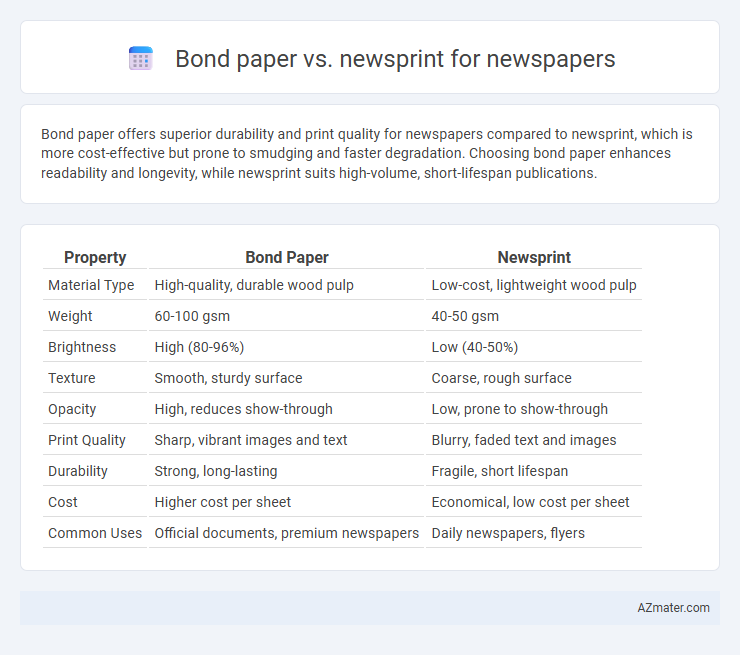Bond paper offers superior durability and print quality for newspapers compared to newsprint, which is more cost-effective but prone to smudging and faster degradation. Choosing bond paper enhances readability and longevity, while newsprint suits high-volume, short-lifespan publications.
Table of Comparison
| Property | Bond Paper | Newsprint |
|---|---|---|
| Material Type | High-quality, durable wood pulp | Low-cost, lightweight wood pulp |
| Weight | 60-100 gsm | 40-50 gsm |
| Brightness | High (80-96%) | Low (40-50%) |
| Texture | Smooth, sturdy surface | Coarse, rough surface |
| Opacity | High, reduces show-through | Low, prone to show-through |
| Print Quality | Sharp, vibrant images and text | Blurry, faded text and images |
| Durability | Strong, long-lasting | Fragile, short lifespan |
| Cost | Higher cost per sheet | Economical, low cost per sheet |
| Common Uses | Official documents, premium newspapers | Daily newspapers, flyers |
Overview: Bond Paper vs Newsprint
Newsprint is a low-cost, lightweight paper primarily used for printing newspapers, characterized by its high porosity and lower brightness, which makes it ideal for quick, large-scale printing. Bond paper, although more expensive, offers higher durability, smoother texture, and better opacity, often used for higher-quality prints and documents requiring longevity. Choosing between bond paper and newsprint depends on balancing cost efficiency with print quality and durability requirements for newspaper production.
Material Composition and Texture
Bond paper is typically made from high-quality cotton or linen fibers, resulting in a smooth and durable texture ideal for sharp print clarity. Newsprint, composed mainly of wood pulp with lower fiber quality, has a coarse and porous texture that absorbs ink quickly but offers less durability. The material composition of bond paper contributes to its premium feel and longevity, whereas newsprint's composition favors cost-effective mass production.
Print Quality and Ink Absorption
Bond paper offers higher print quality for newspapers due to its smoother, denser surface that allows ink to sit on top, creating sharper, more vibrant images and text. Newsprint absorbs ink more readily because of its porous, fibrous composition, often resulting in less crisp prints with potential ink bleed and lower contrast. Choosing bond paper enhances visual clarity and detail, while newsprint prioritizes cost-efficiency despite compromising print sharpness.
Durability and Longevity
Bond paper offers superior durability and longevity compared to newsprint, as it is made from higher-quality wood pulp and often contains additives that enhance resistance to tearing and aging. Newsprint, composed primarily of lower-grade wood pulp with minimal treatment, tends to yellow and deteriorate much faster when exposed to light and air. For newspapers requiring archival quality or extended handling, bond paper provides a more lasting and resilient option.
Cost Efficiency and Budget Considerations
Newsprint is significantly more cost-efficient than bond paper, making it the preferred choice for newspapers with tight budget constraints due to its lower manufacturing and material costs. Bond paper, while more durable and higher quality, incurs higher expenses that can impact overall production budgets and reduce profit margins for large circulation runs. Choosing newsprint balances affordability and acceptable print quality, optimizing newspaper budgets without compromising on mass distribution.
Environmental Impact and Sustainability
Bond paper, often made from higher-quality fibers and treated with chemicals, tends to have a larger environmental footprint due to intensive processing and higher waste production compared to newsprint. Newsprint is typically produced from recycled paper and wood pulp with minimal processing, making it more sustainable and easier to recycle, resulting in lower carbon emissions and reduced deforestation. Choosing newsprint for newspapers supports environmental goals by promoting resource efficiency and reducing landfill impact.
Readability and Visual Appeal
Bond paper offers superior readability for newspapers due to its smoother surface and higher brightness, which enhances text clarity and sharpness, reducing eye strain during extended reading. Newsprint, while more economical, has a rougher texture and lower opacity, leading to ink bleed-through and diminished visual appeal that can compromise the overall reading experience. The choice between bond paper and newsprint significantly impacts the newspaper's legibility, color vibrancy, and the ability to retain reader attention.
Weight and Ease of Handling
Bond paper typically weighs between 16 to 24 pounds per ream, providing a sturdier and more durable surface compared to newsprint, which weighs around 30 to 45 grams per square meter and is much lighter. The heavier weight of bond paper offers easier handling and less tearing during printing and distribution, whereas newsprint is more fragile and prone to damage due to its lightweight composition. Newsprint's lower weight reduces printing costs but requires careful handling to prevent creasing and tearing, making bond paper preferable for high-quality publications.
Industry Preferences and Standards
Newspapers predominantly use newsprint due to its cost-effectiveness, lightweight properties, and suitability for high-speed rotary printing presses, aligning with industry standards for mass circulation and quick turnover. Bond paper is rarely used in newspaper production because its higher quality and heavier weight increase costs and reduce printer efficiency, making it more appropriate for internal documents or premium supplements. Industry preference firmly favors newsprint to maintain economic viability and meet large-scale distribution demands within the newspaper sector.
Choosing the Right Paper for Your Newspaper
Choosing the right paper for your newspaper hinges on balancing quality and cost-effectiveness; bond paper offers higher durability, crisp print clarity, and resistance to ink bleed, making it ideal for premium editions or magazines. Newsprint is more economical, lightweight, and designed specifically for mass circulation, ensuring faster drying times and acceptable print quality for daily newspapers with high volume. Evaluating factors such as budget, print run size, and desired reader experience will guide whether bond paper's superior texture outweighs newsprint's affordability and practicality.

Infographic: Bond paper vs Newsprint for Newspaper
 azmater.com
azmater.com